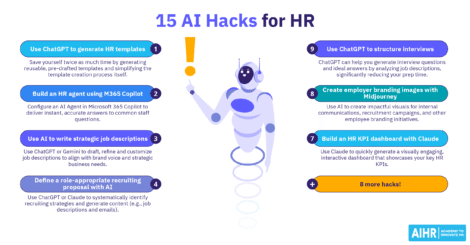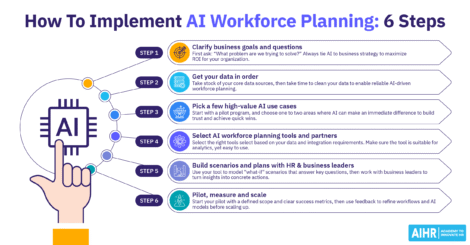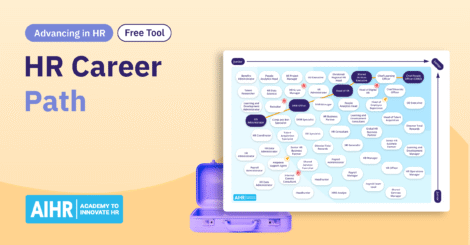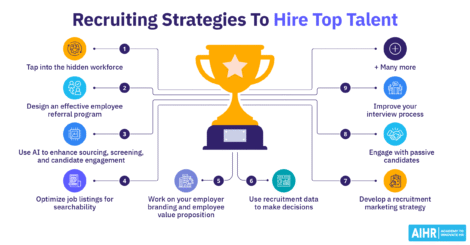ChatGPT, easily one of the most talked-about AI tools right now, is changing the way HR professionals work. This intuitive, conversational interface offers abundant opportunities to save time and increase efficiency.
The demand for this kind of technology is growing fast. ChatGPT had 100 million monthly active users two months after its launch, setting the fastest-ever recorded growing user base. Today, it handles over 2.5 billion user prompts per day and attracts around 4.61 billion visits each month. With instant access to information and task support, using ChatGPT in HR is quickly becoming standard practice.
In this ChatGPT for HR guide, we’ll walk through how ChatGPT fits into the HR world, its potential benefits, the risks you should be aware of, and how to use it responsibly.
And if you want to see how HR professionals are already putting ChatGPT to work, download our ChatGPT Prompts for HR Guide. It’s filled with practical, ready-to-use prompts to help you streamline your tasks and get more done.
Contents
What is ChatGPT?
How to use ChatGPT for HR: 7 examples
ChatGPT prompts for HR
Free ChatGPT for HR cheat sheet (Excel)
HR tasks ChatGPT won’t be able to replace
ChatGPT limitations and risks for HR
ChatGPT and HR ethics: Best practices for responsible use
FAQ
What is ChatGPT?
ChatGPT is an AI-powered chatbot that consists of two parts:
- Chat, which refers to its ability to simulate human conversation
- GPT, short for Generative Pre-trained Transformer.
Put simply, a generative pre-trained transformer can comprehend, generate, and manipulate text, image, video, and audio data to answer questions, complete tasks, and solve problems. It’s an algorithm that produces a chatbot’s human-like, contextually relevant conversations via text or voice interactions. It works by predicting the next word in a sequence based on patterns it has learned from large volumes of training data.
ChatGPT was released in 2022 and is developed by OpenAI, an artificial intelligence (AI) research lab and company founded in 2015. Both free and paid versions of ChatGPT are available.
While ChatGPT is probably the most recognized GPT tool, it’s not the only one. Alternatives include Google’s Gemini, Microsoft Copilot, Perplexity AI, and Claude AI. In the HR space specifically, options like Talent Match Pro, Leena AI, and HRGPT have also emerged.
GPT tools are capable of performing a wide range of tasks, such as:
- Drafting essays and reports
- Writing and debugging code
- Editing, translating, and summarizing content
- Creating charts and tables
- Generating Excel formulas
- Powering automated customer service interactions.
How to use ChatGPT for HR: 7 examples
Generative AI is becoming integral in improving efficiency across Human Resources. Research shows that at least 40% of HR functions in international companies already use AI applications. With a wide range of application opportunities, generative AI helps HR teams streamline tasks, boost productivity, and improve the employee experience.
So, what can ChatGPT do for HR? Here are seven examples:
1. Handle repetitive tasks
HR professionals often deal with recurring, time-consuming administrative tasks. With ChatGPT, HR can provide quicker responses with fewer errors to better meet employee needs, leaving more time to focus on strategic activities.
Tasks ChatGPT can support include:
- Answering common employee queries
- Updating employee records
- Drafting emails and documents
- Creating and editing contracts, policies, and handbooks
- Framing sensitive messages for difficult HR conversations
- Generating and analyzing employee surveys.
2. Accelerate the search for talent
ChatGPT can make the recruitment process more efficient by cutting down manual work and offering data-informed support for better candidate selection.
It can help with:
- Screening and shortlisting candidate resumes or applications
- Writing and refining job descriptions
- Matching job openings with candidate profiles
- Creating screening and interview questions
- Scheduling interviews.
3. Identify causes of employee turnover
ChatGPT can detect potential reasons for employee turnover by analyzing qualitative HR data such as exit interviews, employee surveys, or feedback. It can identify patterns, detect common themes, and highlight areas for improvement. With this awareness, HR can take proactive measures to address issues, boost employee satisfaction, and reduce turnover.
GenAI is transforming the way work gets done, and knowing how to use it effectively in HR can give you a serious advantage.
AIHR’s Generative AI Prompt Design for HR course teaches you how to craft the right prompts to get the best results from AI tools. This self-paced online course walks you through practical techniques to streamline your work, improve decision-making, and enhance HR processes using GenAI.
Learn how to work smarter with AI and make a bigger impact in your role.
4. Enrich employee engagement
ChatGPT’s ability to provide personalized responses to employee questions, offer company policies and benefits guidance, and facilitate communication between HR and employees ensures better HR service delivery to meet employee expectations. ChatGPT can also assist in developing employee engagement initiatives, such as surveys or recognition programs.
5. Automate onboarding and customize learning
A GPT-powered chatbot can guide new hires through the onboarding process and answer their questions regarding procedures, policies, and benefits to help them acclimate smoothly. It can also assess job roles and learning needs to create personalized training modules that improve retention.
6. Assist in policy research and benchmarking
When HR needs to create or update policies, ChatGPT can quickly synthesize external information and internal guidelines to support well-informed decisions.
It can help with:
- Researching local labor laws and compliance topics
- Comparing internal policies with industry standards
- Summarizing long policy documents for quick reference.

ChatGPT prompts for HR
What you get from ChatGPT largely depends on the quality of what you put in. To get useful, accurate responses, your prompts need to include the objective, context, and preferred format. The more detailed your input, the better the output.
Below are prompt examples tailored to HR responsibilities across the employee life cycle:
Talent attraction
| Topic | ChatGPT prompt example |
| Job descriptions | “Write a job description for a [title] position at an [industry] organization. Include the following responsibilities and qualifications: [A, B, C, etc.].” |
| Employer branding on social media | “List 5 employer branding post ideas for Instagram and LinkedIn that convey company culture and employee sentiment. Explain how these ideas engage job seekers.” |
Recruitment
| Topic | ChatGPT prompt example |
| Interview questions | “List 4 interview questions that assess a person’s interpersonal communication skills. For each question, provide example answers that a highly skilled candidate and a low-skilled candidate would give.” |
| Job offer template | “Write a professional, welcoming job offer email to a candidate named [name] for a [job title] position at [company name]. Include the start date of [date], a starting salary of [salary], and next steps for accepting the offer.” |
Onboarding
| Topic | ChatGPT prompt example |
| Onboarding checklist | “Create an onboarding checklist and best practices for onboarding a new [job role] working a hybrid schedule. Include: • Preboarding preparations • First day/week activities • Role-specific training path • Resources for ongoing support • Strategies for integrating new hires into their team and the company culture.” |
| Onboarding survey | “Formulate a 10-question onboarding evaluation survey to collect feedback from new hires after 30 days of employment. Use multiple-choice questions to rate topics such as: • Clarity and ease of the onboarding process • Quality and adequacy of training and resources • Understanding of job duties and performance expectations • Communication from managers and team members • Suggestions for improvement.” |
Development
| Topic | ChatGPT prompt example |
| Training resources | “Find 5 online training programs for a [job title] to learn about [topic] and summarize each course’s offerings and participant reviews.” |
| Coaching support | “Provide 10 questions a manager can pose to take a coaching approach to the performance review of a [job title].” |
Retention and engagement
| Topic | ChatGPT prompt example |
| Employee recognition | “Find 7 creative ideas for employee recognition that go beyond monetary rewards. They should be suitable for different work environments, including both remote and in-person teams.” |
| Employee engagement survey | “Generate 12 employee engagement survey questions that will measure how satisfied, motivated, and connected employees feel at work. The questions should be concise and have a friendly tone. Include both multiple-choice and open-ended questions that cover matters such as work environment, professional growth opportunities, perception of leadership, and work-life balance.” |
Offboarding
| Topic | ChatGPT prompt example |
| Exit checklist | “Develop a customized employee offboarding checklist with space for inserting the employee’s name, department, and last workday. Include activities such as collection of company property, notifications to relevant departments, records updates, disabling accounts, and final pay/benefits instructions.” |
| Exit announcement | “Compose a company-wide email to announce an employee’s departure. Use a respectful and upbeat tone and include farewell wishes that show appreciation for the employee’s contributions and support for their next steps.” |
Free ChatGPT for HR cheat sheet (Excel)
Using ChatGPT in Excel can help you work more efficiently with your data. With the right prompt, ChatGPT can write formulas, fix errors, generate sample HR data, and even explain what’s going wrong in your spreadsheet.
Designed specifically for HR professionals, this cheat sheet provides ready-to-use prompts that save time and reduce guesswork. Whether you’re calculating headcount trends, tracking training hours, or troubleshooting a #REF! error, these examples show exactly how to ask for help (and what to expect in return).
HR tasks ChatGPT won’t be able to replace
While ChatGPT and other AI tools can make HR work easier, they’re not a substitute for human judgment, empathy, or strategic thinking. Some responsibilities still require the expertise and perspective only people can bring.
Here are a few examples:
- Handling complex or sensitive employee relations issues: ChatGPT is capable of recognizing trends in employee feedback and identifying red flags in sentiment analysis. However, certain work situations, such as interpersonal conflict, misconduct, and bias awareness, require empathy, discretion, and ethical oversight. It takes personalized conversations framed with the proper context, nuanced understanding, and legal cognizance to navigate and resolve these circumstances successfully.
- Developing strategies and driving change: While the AI-driven tool might help with writing outlines or sections of a strategy, it can’t fully create and implement one. It lacks the correlated experience, situational awareness, and ethical judgment required to balance organizational goals with employee wellbeing. The same goes for driving organizational change. ChatGPT can play a supporting role by analyzing data and drafting communications, but implementing change initiatives involves authentic human trust and leadership.
- Shaping organizational culture: Instituting company culture and influencing leadership entails ongoing influence through human connection. ChatGPT cannot facilitate HR’s role in aligning managers and employees with the culture, fostering a sense of ownership, and maintaining accountability throughout the company.
- Leading leadership development and succession planning: Metrics and competency assessments are not enough to identify and develop the best future leaders. It calls for the ability to perceive potential and motivation in employees while considering business needs and long-term fit. Making these judgment calls and coaching future leaders goes beyond ChatGPT’s abilities. It takes organizational insight, observation, intuition, and the ability to engage in meaningful personal interactions that inspire and guide growth.
Other HR activities will also continue to rely on human intervention, like managing workforce ecosystems, evolving remote and hybrid work models, fostering purpose-driven organizations, and redesigning how learning happens at work.
HR tip
Three factors determine what ChatGPT can and cannot do: knowledge, context, and format. While AI has tremendous amounts of knowledge at its disposal, it lacks real-world context. So when a task depends on situational understanding or emotional nuance—like shaping culture or setting strategy—the human touch remains essential.
ChatGPT limitations and risks for HR
ChatGPT is a powerful tool, but like all generative AI, it has limitations. Understanding these is essential, especially in HR, where accuracy, fairness, and confidentiality are critical.
ChatGPT limitations
- Incorrect answers that seem right (hallucinations): ChatGPT sometimes generates confident-sounding answers that are factually incorrect, a phenomenon known as ‘hallucination’. Even OpenAI CEO, Sam Altman, stated on a recent podcast that AI hallucinates, and admitted that ChatGPT is “not super reliable”. He also explained that hallucinations in AI occur due to several factors, including “biased training data, lack of grounding in real-world knowledge, pressure always to respond, and predictive text generation”.
- Biased answers: Like any AI system, ChatGPT reflects the data it was trained on, and that data can contain human biases. As a result, it can mirror the same prejudices, flawed assumptions, or cognitive biases found in real-world decisions. This issue continues to be a struggle for the progress of generative AI. A recent study comparing ChatGPT versions 3.5 and 4 found improvements in solving problems with precise answers, but noted that behavioral bias increased in tasks involving personal preferences and judgments.
- Lack of source transparency: The free version of ChatGPT doesn’t provide references, footnotes, or links, which can make it difficult to verify the information it generates. It has also been known to fabricate or misattribute sources when asked for citations. While the paid version includes web browsing, it only retrieves real-time information or provides sources when specifically prompted, and even then, the quality and formatting of those sources can vary. Prompting strategies and careful review are still necessary, especially when accuracy is critical.
- Outdated information: ChatGPT’s free version (GPT-3.5) isn’t updated in real time and has a knowledge cutoff of October 2023. It cannot access the internet or provide current information. The paid version (GPT-4-turbo) shares the same cutoff, with some additional tuning into early 2024. However, it can use web browsing, if prompted, to retrieve newer information. For HR professionals trying to stay up to date on evolving laws, best practices, or policy changes, this is an important limitation to keep in mind.
HR tip
Three out of four HR leaders list bias as a top concern when adopting AI. To manage this, treat ChatGPT’s outputs as a draft, review them with a DEIB lens, and apply human oversight before making decisions.
ChatGPT risks
These limitations create several real-world risks if not managed carefully:
- Bias in decision-making: If left unchecked, AI tools open the door for bias to seep into various HR processes. This previously occurred at Workday, where their AI systems and screening tools allegedly disqualified applicants who were Black, disabled, or over 40 at a disproportionate rate. Additionally, a randomized study showed that GPT-3.5 Turbo rated identical resumes 0.45 points higher for female candidates than for male ones, revealing bias in gender-based evaluation.
- Inaccurate HR guidance: Because ChatGPT’s outputs are based on patterns rather than fact-checking, it can deliver outdated or incorrect HR advice. Relying on flawed outputs could lead to poor decision-making, compliance issues, or even legal exposure.
- Data privacy and cybersecurity: Employees may use ChatGPT informally, sometimes entering confidential information without company oversight. This creates a data privacy risk, particularly when the organization doesn’t have clear policies around AI usage.
ChatGPT and HR ethics: Best practices for responsible use
Because of its importance, this topic deserves a much deeper dive. For now, though, let’s cover the basics of ethically using ChatGPT (and all AI-driven tools) in HR:
- Make a plan: Define ChatGPT’s purpose and appropriate use within the HR function. Identify which tasks or activities it can and can’t be used for. As the tool is not yet error-proof, it’s wise to only use it in ways that can be monitored for inaccuracy and bias. A cautious approach to adopting it for remaining duties and decisions is warranted.
- Test drive the tool: Before integrating ChatGPT into the various stages of the employee life cycle, experiment with it for a trial period. Assess whether ChatGPT holds value for your HR team and determine its applications and rules for use.
- Do due diligence: ChatGPT might not provide you with the most up-to-date or accurate information, so don’t take its output at face value. Fact-check and further research the accuracy of the results before including anything provided in a process or task.
- Avoid sharing sensitive or personal information: Unless you know exactly how ChatGPT handles your data, be careful about what you share in the chats, and don’t input sensitive employee or candidate information. For example, a recent ChatGPT glitch allowed users to see the titles of other users’ conversations.
- Be transparent about how HR uses ChatGPT and other AI tools: Inform employees that HR has implemented AI tools in HR processes and what their purpose is. Communicate how employee data is collected, explain what it’s used for, and outline the safeguards that will maintain employee privacy.
- Create a ChatGPT policy for employees: As mentioned earlier, employees are increasingly using ChatGPT, both openly and secretly. To confront this, develop a generative AI policy with explicit guidelines for the appropriate use of AI tools that clarify any restrictions or required approvals. Some companies monitor the information shared on an AI platform. Others, such as JPMorgan Chase and Moderna, have introduced a company-sanctioned GPT in the workplace.
- Get professional advice: Before integrating ChatGPT more deeply, get input from your IT, Legal, and possibly cybersecurity teams. The use of generative AI is relatively uncharted territory; therefore, seek guidance from specialists who understand the risks and security protocols.

Over to you
ChatGPT is a useful tool for HR, capable of boosting efficiency by generating content, answering questions, and taking on repetitive tasks. Used thoughtfully, it can be a strong asset.
However, it’s not a plug-and-play solution. Because it comes with limitations and ethical concerns, HR leaders need to develop a plan for responsible use, one that includes oversight, policies, and safeguards. Complex or sensitive HR matters still require a human approach rooted in context, empathy, and judgment.
FAQ
ChatGPT can understand and compose human-like text responses, making it capable of providing information, answering questions, and engaging in discussions on a wide range of topics. It can assist HR professionals in tasks such as generating creative ideas, offering suggestions, providing explanations, and analyzing data.
There’s no one-size-fits-all answer. The best AI tool depends on your organization’s size, goals, and specific HR needs. That said, ChatGPT is one of the most accessible and versatile options. It can support document drafting, information retrieval, and light data analysis. When used responsibly and with awareness of its limitations, it can significantly lighten HR workloads.

















